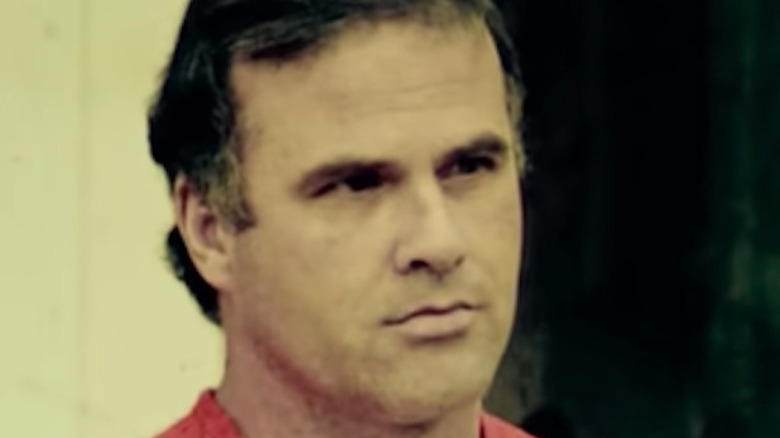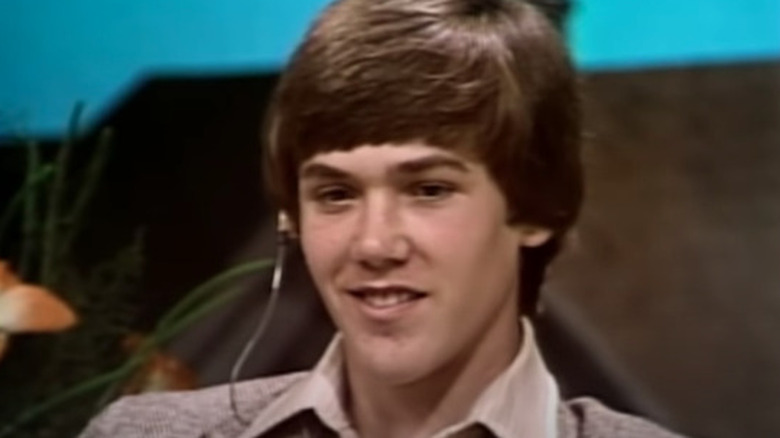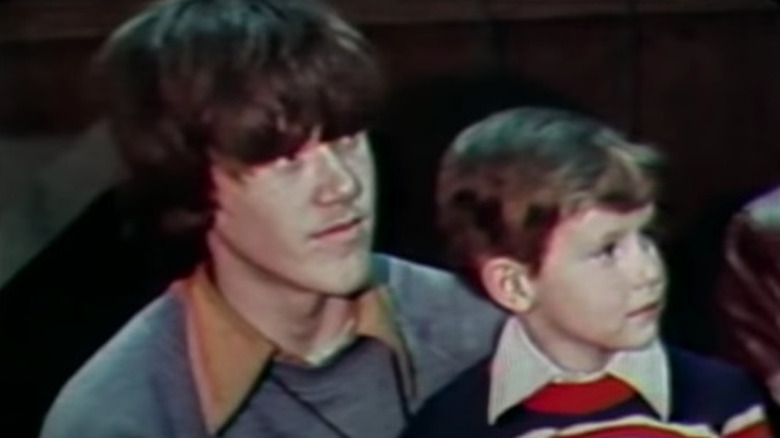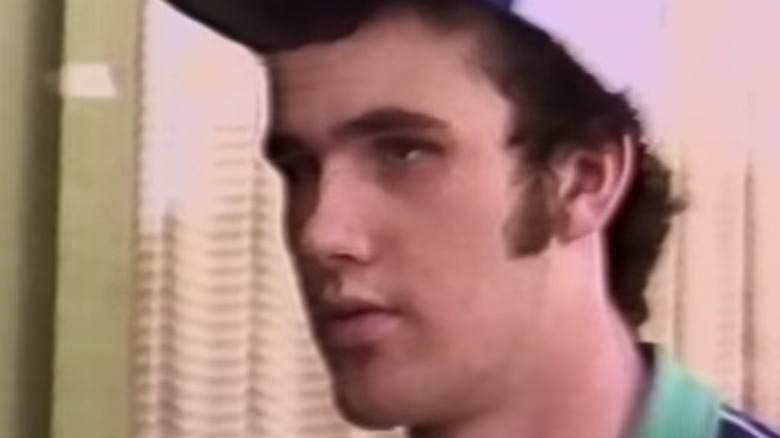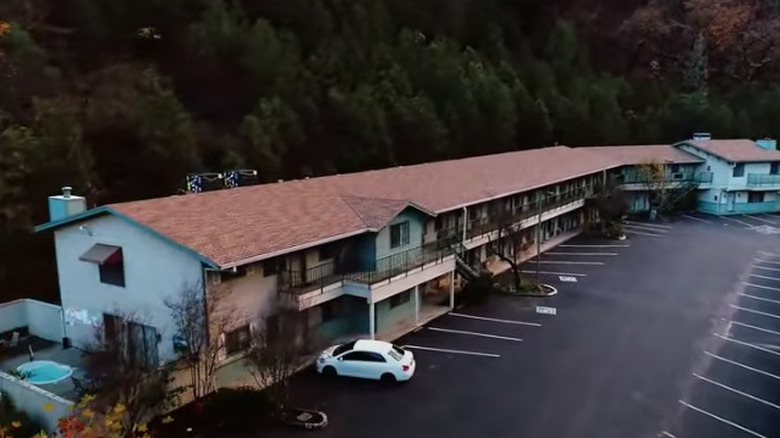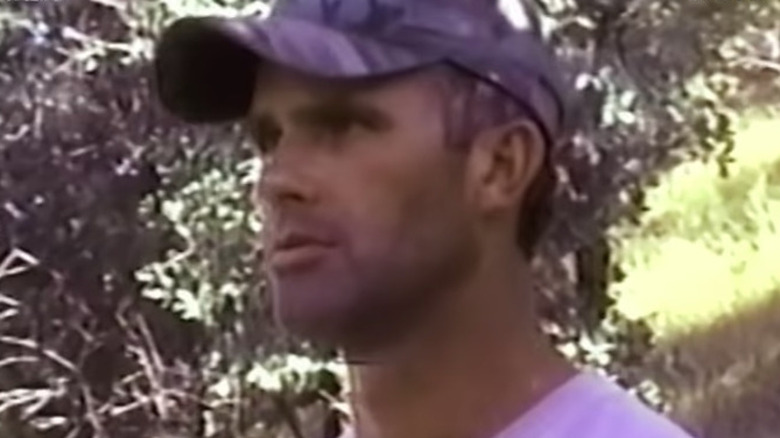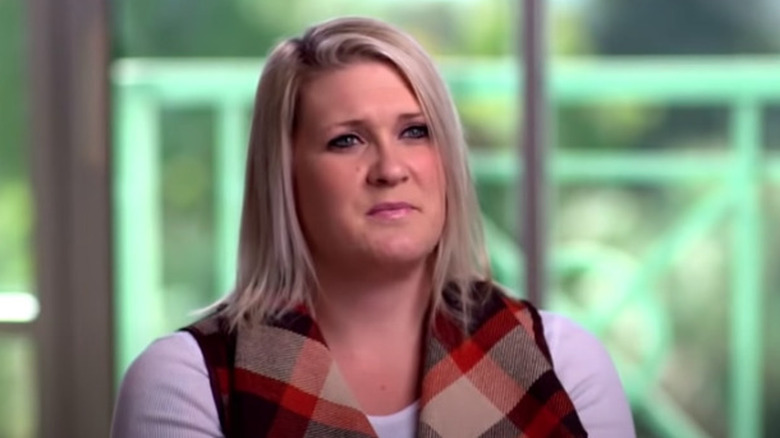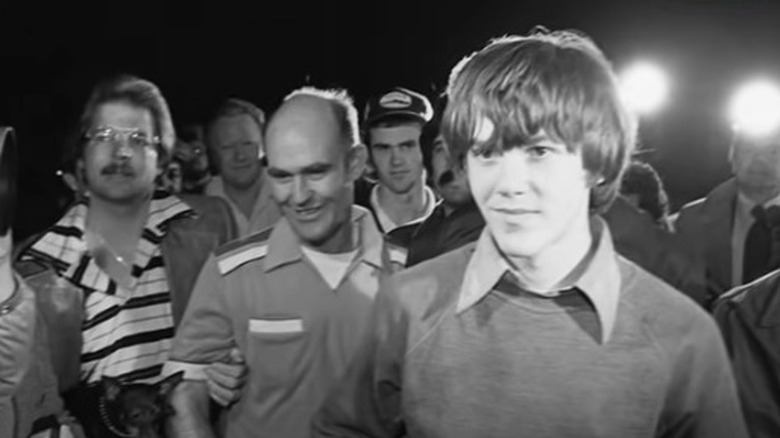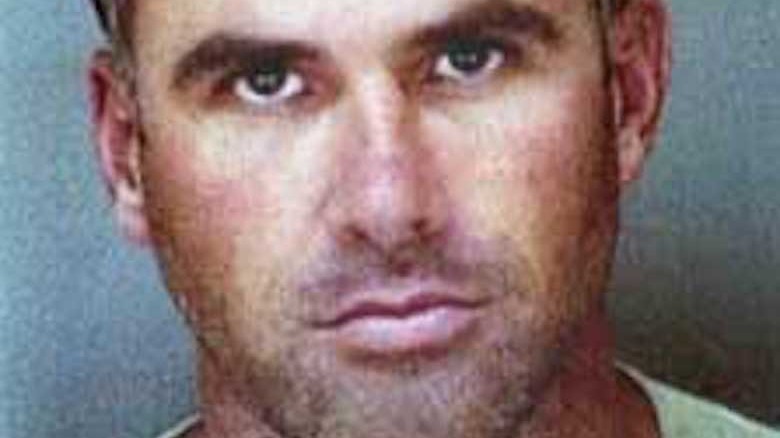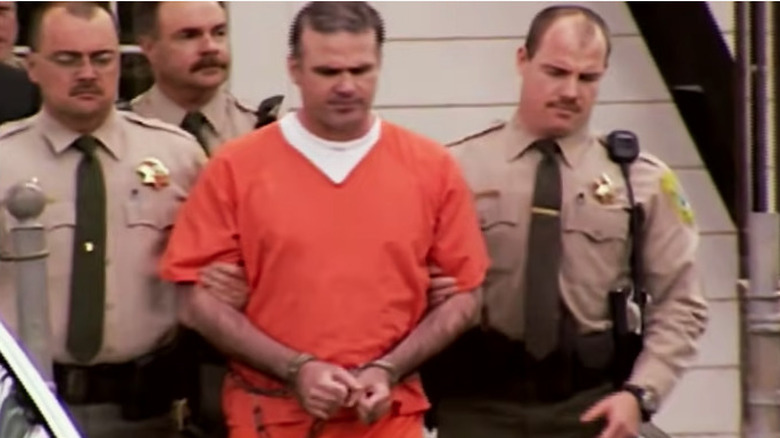The Untold Truth Of Serial Killer Cary Stayner
Few families have seen so much tragedy and horror as the Stayner family. One son was abducted when he was 7-years-old. The other grew up to become a serial killer who terrorized the Yosemite forest. The brothers, Cary and Steven Stayner, were dual opposites; although Cary didn't experience the same abduction ordeal as his younger brother, Steven, he dealt with his own demons and ultimately succumbed to them through rape and murder.
Their remarkably dark and tragic lives are told in Hulu's recent documentary "Captive Audience: A Real American Horror Story." In the documentary, Steven's younger sister, Cory, says that the family wanted to return to normal after Steven's return home, but the media attention made that task difficult, according to People. Publicity would prove to be the least of their worries. In 1989, Steven tragically died in a motorcycle accident at 24 years old, per A&E. Then in 1999, Cary murdered two women and two teens and was sentenced to death a few years later. Here are some untold facts about Cary Stayner's grim past and his monstrous crimes.
Cary's brother, Steven, was abducted and missing for 7 years
On December 4, 1972, Steven Stayner was walking home from school on the side of a highway when a white Buick pulled up beside him. Inside was Kenneth Parnell and his friend Ervin Murphy. Parnell convinced 7-year-old Steven that his parents no longer wanted him by pretending to speak to them on a payphone. The naive child believed the pedophile and thereafter began a new and dark life with Parnell as his abusive father figure. Parnell changed Stayner's name to Dennis Parnell and enrolled him in a new school, 300 miles away from where his real siblings attended. Parnell proceeded to sexually abuse Stayner for the next seven years.
Steven's older brother, Cary Stayner, took his disappearance particularly hard. Cary had been a doting older brother who played with Steven. When Steven was abducted, Cary had wished upon a star every night that Steven would return, per SFGate. His father, Delbert Stayner, admitted that he became so obsessed about finding Steven at the cost of his relationship with his other children, according to SFGate. He was inattentive and dour toward his other children, and family road trips involved searching for their missing brother whenever new tips emerged.
Cary was overwhelmed by Steven's return
Steven Stayner escaped Kenneth Parnell when he was 14 years old. That year Parnell recently kidnapped another young boy to replace the aging Stayner, 5-year-old Timothy White. Stayner told his high school girlfriend that he was determined to save White from Parnell, according to ABC News. Stayner and White left while Parnell was at work and took refuge at a police station, where they informed authorities of their abduction. Stayner's resolve to rescue White made him a national hero. He was interviewed by Good Morning America a few times and his story was adapted into a book and movie.
Steven was a different person when he returned to his home in Merced, California. He was seven years older and no longer the little brother Cary had once bonded with. The two brothers now had to share a room, but they didn't get along. Steven was famous, and now Cary was living in his shadow. When interviewed by GMA shortly after his return, Steven said although his parents changed little, he didn't recognize his siblings, per ABC News. Psychiatrist George Woods, who evaluated Cary while he was in prison, said Steven's return was stressful for Cary since he was dealing with mental health issues and obsessive thoughts at the time, per SFGate.
Cary Stayner was abused by his uncle
Unlike his brother, Cary Stayner wasn't abducted, but that hardly meant his home was safe. During his murder trial, Staynor's defense lawyers — who were trying to save him from a death sentence — revealed a long history of child abuse in the Stayner home. Cary Stayner had been sexually abused by his uncle, while his sisters were abused by their father, Delbert Stayner. In 1986, Delbert was court-ordered to therapy after abuse allegations. The Stayners' family history of pedophilia had long been a problem, one that may have lasted for three generations, according to SFGate. Cary's mother, Kay Stayner, had also been molested by her own father, per SFGate.
Cary's uncle had been formerly convicted of child molestation, but he was still allowed to spend time alone with him. After Steven had been abducted, Cary and a cousin spent a night with their uncle, who showed them nude photos of underage girls. They then slept in the same bed, and Cary awoke to his uncle attempting to molest him, according to SFGate.
Stayner was a creep in high school
From one perspective, it seemed Cary Stayner had found his niche among his peers in school. Although he was quiet and kept to himself, he was an avid cartoonist who spent time in his class for gifted students doodling and drawing caricatures of people. He read comics and listened to metal, according to SFGate. In high school, he served as the cartoonist for the student paper and was voted "most creative" by his classmates, per ABC News. Those who knew him assumed he would go on to become a graphic artist or a professional cartoonist.
But Stayner made some around him feel uncomfortable, particularly girls his age. When his sister had a sleepover, he crawled under the bed of one of her friends in order to touch her breasts. She told him to stop, and he left only to reappear nude at the doorway. She had to tell him to leave a second time, per SFGate. Stayner had trouble developing relationships with girls, despite some interest from them. He was attractive, and girls would tell his friends that they would like to date him, but Stayner never pursued a relationship and remained alone. According to local reporter Ted Rowlands, Stayner wanted to connect sexually with girls but struggled to have normal relationships with them (via ABC News).
Stayner grappled with his mental health
While in prison, Cary Stayner's defense lawyers ordered a psychiatric evaluation on him, per SFGate. This included a positron emission tomography (PET) scan, an imaging test that can detect brain diseases and disorders, per MedlinePlus. The results showed that his mental issues were aligned with schizophrenia and other mental disorders. His mental health issues predated his brother's abduction. When he was 2 years old, Stayner began pulling out his own hair. He had to wear a hat to school to cover up the bald spots, which led to bullying.
As a child, Stayner suffered from intrusive images in his head, including thoughts about his mother being kidnapped. When was 7, he imagined himself killing female cashiers at a grocery store, per SFGate. When he was an adolescent, he began having dark, sexual fantasies involving rape. He thought he heard voices and other mysterious noises, like messages emanating from the television. Stayner was once driven by a friend to a psychiatric center after hitting his bloodied hand against a piece of plywood and saying he wanted to set his workplace on fire with his boss and coworkers inside, per SFGate. According to his evaluation, Stayner's murder of a mother, her teen daughter, and her daughter's friend at Yosemite came as a result of these violent thoughts.
He carried out his murderous fantasies at Yosemite National Park
On February 15, 1999, Yosemite tourists Carole Sund, 42, her daughter Juli Sund, 15, and exchange student Silvina Pelosso, 16, went missing, per SFGate. They were staying at Cedar Lodge at the edge of Yosemite National Park. Carole and Pelosso's bodies were found burned and in the trunk of Carole's rental car. A month later, Juli's body was found 40 miles away. Cary Stayner, who had been working as a handyman at Cedar Lodge for less than two years, was responsible for the murders.
However, it took several months for investigators to realize Stayner was behind the killings. Perhaps confident in his evasion, he sent FBI investigators a letter with a map, detailing where he had left Juli's body and hinting that he had sexually assaulted the body. And on July 21, Stayner killed again. His next victim was 26-year-old park naturalist Joie Armstrong, who had been staying in a cabin at the park. Her body was found decapitated near a stream in the forest. Stayner later told investigators that he had bound Armstrong and forced her into his car, and she heroically escaped before he caught up to her, according to ABC News. An FBI agent said that Stayner recounted his crimes "as if he was reading a soup label," (via ABC News).
Police didn't suspect him initially
Investigators initially didn't suspect Cary Stayner as a suspect, despite spending much of his time in the area. He was always nearby and on hand, opening rooms at the Cedar Lodge for investigators to search for evidence. When a tip was called in about Stayner's car, which had been parked near the crime scene, investigators only thought of him as a potential witness, per ABC News.
At first, they believed the perpetrator was already in custody; this proved to be a fatal mistake. After Stayner's first murder spree, he hired a cab driver to take him away from the area. In the car, Stayner started rambling about seeing Bigfoot in the woods. The driver was taken aback by his strange behavior but did nothing about it since the FBI had publicly announced that the killer was likely in custody, according to ABC News. When investigators finally began to suspect Stayner six months later, he had already murdered again.
By then police had charged two other men for Stayner's initial murders — two brothers who had a criminal record, per ABC News. Stayner had been arrested the same day Joie Armstrong's body was found but for a different crime. He was found smoking marijuana and brought in for questioning. However, due to an error, he was released, according to ABC News.
Stayner fled to a nudist colony
On July 23, when Cary Stayner was released from custody for his marijuana charge, he quickly packed up and left for Laguna del Sol, a nudist colony, according to ABC News. He had visited the resort before in March after his first murder spree, and he lived there in a tent beside a lake. Stayner's days of freedom were soon over once he visited the colony's bar. He started chatting with one of the bar's regulars, Janet Damant. She had spoken to him before during his March trip, so she was aware of his employment at Cedar Lodge. He had told her then that he left because the police presence was overwhelming. This time, in July, Stayner told Damant that he intended to move to Oregon or Utah.
Meanwhile, investigators began to suspect Stayner and released his name to the public. The day after she spoke to Stayner, Damant watched the news and saw that the FBI were looking for Stayner. The FBI provided a number in case anyone saw him, which Damant called, per Esquire. When the FBI arrived at the restaurant, Stayner was eating breakfast. He was easy to spot because he was the only person wearing clothes, per ABC News.
Stayner originally intended to kill his girlfriend and her daughters
When Cary Stayner was questioned by FBI agents, he immediately confessed to the four Yosemite Park murders and provided a detailed accounting of his crimes. He also revealed a disturbing truth: he originally intended to kill his girlfriend and her daughters before he went on to target Carole Sund, Juli Sund, and Silvina Pelosso on February 15, 1999. On the day of those murders, Stayner spent most of his time with his girlfriend and her family, per ABC News.
That girlfriend worked at a restaurant at Cedar Lodge. One of her daughters, Lenna, was interviewed by ABC's 20/20 in 2019 and said she and her sister were excited whenever Stayner visited. He taught them how to dive into the water and bought them a new Beanie Baby with every visit. However, she remembers feeling uncomfortable with him when he once stripped completely bare in front of them at the Merced River. He often carried a backpack that she later found out contained his murder weapons.
After his arrest, the FBI later informed her mother of Stayner's original intentions, which involved killing them all and raping Lenna and her sister. Stayner considered doing it on three different occasions. Before leaving for the nudist colony — and after murdering his last victim — Stayner went looking for Lenna and her family, but luckily they were gone visiting their grandmother. An FBI agent believed they would've been Stayner's next victims had he not been caught, per ABC News.
Cary wanted Steven's fame
When Steven Stayner made his heroic return home, he became famous and his story engrossed the nation. The tale of his abduction and escape was adapted into a book and novel, both titled "I Know My Name First Name Is Steven." The film was a two-part mini series that debuted in 1989, per TCM. It was nominated for four Emmys and a Golden Globe, according to the Independent. Stayner himself played the part of a police officer in the second part of the series. On top of that, cameras were constantly following Stayner. He was interviewed on TV before he was able to reunite with his parents and even their reunion was on display.
Despite the problems that all the publicity caused for Steven — including bullying and a general lack of privacy — his older brother Cary seemed to envy it. The Stayners' neighbors told SFGate that Cary felt disregarded by Steven's fame and wanted that same attention and publicity. When Cary confessed to the four Yosemite murders, he asked authorities to contact Hollywood producers so that his story could be made into a movie, just like his brother's. However, during Cary's murder trial, his attorneys argued that he never wanted fame or attention, calling him a "shrinking violet," per the Independent.
Stayner was sentenced to death
At the end of his murder trial in 2002, Cary Stayner was sentenced to death for the murders of Carole and Juli Sund and Silvina Pelosso. The trial was so emotionally charged that Judge Thomas C. Hastings had to leave the room to gather himself, and when he returned, he appeared as if he had cried. Stayner's defense attorneys positioned Stayner as a victim of mental illness and trauma, stemming from his brother's abduction and having been molested as a child, according to SFGate.
Stayner's attorneys request that the location of his trial be moved away from the area surrounding Yosemite in order to guarantee him a fair trial was granted, per The Los Angeles Times. The attorneys also requested a new trial since it appeared that three jurors were victims of child molestation, but the judge rejected the motion. Stayner's parents, who apologized to the families of the victims, advocated against the death penalty. He had already been given a life sentence without parole for the murder of Joie Armstrong in an earlier trial. But for the murders of the three female tourists, prosecutors were not going to let him get off so relatively easy; they were determined to give him the maximum penalty.
Cary Stayner is still on death row
Cary Stayner's death sentence was automatically appealed a long process that, at the time, could have meant more than a decade of waiting, per SFGate. In California, 900 people were sentenced to death between the years 1978 and 2019. Only 13 were executed, according to KMPH News. In 2019, California Governor Gavin Newsom placed a moratorium on executions, halting the process for 700 inmates, including Stayner.
Stayner is now 60 years old and is currently being held in San Quentin State prison, per California's Department of Corrections and Rehabilitation. San Quentin is a notoriously tough place to live with a checkered human rights history. In 2021, it was penalized around $400,000 for safety violations that resulted in a COVID-19 outbreak and 28 inmate deaths, per CNN. Because Stayner is on death row, he likely lives in a 48-square-foot single cell with only five hours of exercise allowed outside. Death row inmates are also allowed showers every other day, but they shower alone and not in groups per KALW News.
